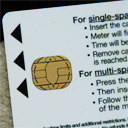 Where’s my identity? Well, of course, it’s my brain and body, to be sure, and all of that stuff I’ve done during my lifetime, and all the connections I’ve made, but then again, my personal data is all over the place so who knows how much of me might be scattered around in many places?
Where’s my identity? Well, of course, it’s my brain and body, to be sure, and all of that stuff I’ve done during my lifetime, and all the connections I’ve made, but then again, my personal data is all over the place so who knows how much of me might be scattered around in many places?
The thought occurred because I got out of my car a few weeks ago without turning it off, and when I returned to it several hours later, it was still on.[1] Nobody had messed with it, but it had remained there at the curb completely “on” and drivable. My “identity” as far as the car was concerned was the RFID “key” that I was carrying with me.
Where else have we embedded or attached our identities to physical objects these days?Another obvious place to look for identity is in the computer. Yup, that’s true for me. My passwords, URLs for my bank sites, information about things I’ve bought (info that I retain for warranty purposes – I scan my receipts so I don’t lose them) – all of that is in my computer. These are the keys to my everyday activities. I keep these doubly-encrypted (one encrypted virtual volume inside another one) so they can’t be stolen or used if I lose the computer, but that’s where they are – inside the computer.
Backups. Yes, I have backups of all of this too. Genetic duplicates, so to speak. They’re kept on disk drives, encrypted, inside a double fireproof safe at the office. Yes, again I like redundancy, one fire-resistant safe inside another larger one. And I keep a printout of my passwords too.
Do I let web site keep copies of my credit card numbers? Well, not often. Probably fewer than six sites have a credit card each. But that’s convenient for me because they charge me monthly for services, so I have to distribute some DNA to them or I’d be checking back every month.
My passport is actually my primariy ID document, even though most of my travel is within the US. And mine does not contain an RFID chip (though the passport number can be read by machine). Next time I renew, it will be all tricked up with a chip.
 When I parked near the bank today, I used a smart-card to pay the parking meter. I buy $20 or $50 in advance, and the card can be inserted into any City of San Francisco parking meter and tick-tick-tick I buy whatever amount of time I want on the meter.
When I parked near the bank today, I used a smart-card to pay the parking meter. I buy $20 or $50 in advance, and the card can be inserted into any City of San Francisco parking meter and tick-tick-tick I buy whatever amount of time I want on the meter.
 I have a similar smart card for Kinko’s (oops, FedEx Office now) so I can walk in, put the card in the copier, make copies and walk out without having to wait in line to pay.
I have a similar smart card for Kinko’s (oops, FedEx Office now) so I can walk in, put the card in the copier, make copies and walk out without having to wait in line to pay.
When I part at San Francisco International Airport, I put a credit card into the kiosk at the entry. The kiosk notes the credit card information, and doesn’t give me a paper ticket. When I’m ready to leave, I put the same card into the exit kiosk and it rings up the charge, giving me a paper receipt (wish I could suppress that).
I have my [coffee chain whose name won’t be mentioned]’s card too. With “money on the card” I just walk in, order, they swipe the card through the register, and bingo I’m done. Just like gift cards in millions of other places. (I’d say the majority of the cards with numbers starting in the 6000’s are gift cards these days.) In these cases, there’s nothing smart about the card – the transaction is processed like a credit/debit card transaction and the real information is “in the system.”
I went to vote on Tuesday. Refreshing, because all I had to do was state my name, they looked me up, I signed, and I voted. No voter card, or driver license required. Now, that was easy.
[1] I say “without turning it off” because it’s a Prius that you turn on and off (you don’t really start a Prius like you start a non-hybrid with a starter motor and all of that), and the key system is an RFID that’s fastened to my keychain (actually a carbiner – a real one, not one of the little fake ones), and I can start the car without inserting the key into any ignition switch – it just has to be inside the car. You start the car by pushing an on/off button (O or |) once you’re inside. When you leave the car, you have to push the on/off button if you want the car to turn off. Otherwise, if you leave it remains running and can still be driven until it’s turned off again. Because the car is a hybrid, you don’t necessarily hear it running when you step out, and it’s possible if not actually easy, to make this mistake.
[2, gratuitous] Are Computers Transforming Humanity? ComputerWorld, May 2009
Leave a Reply